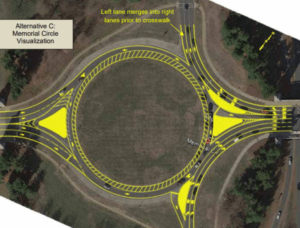The drive through Memorial Circle, just across Memorial Bridge from the Lincoln Memorial provides one of the most picturesque views of the nation’s capital — it’s also one of the most torturous commuting choke points in the region.
The National Park Service has completed its preliminary plan to untangle the hard-to-predict lane changes and traffic patterns for drivers leading up to the circle, while making it safer for pedestrians and bicyclists.
The decision comes after consideration of three possibilities — one which would have made no changes, a second which would improve signage and lane striping, and the chosen alternative, which will modify road configurations, and add safety devices at targeted hot spots, to reduce conflict.
“Whether you are a frequent commuter, visitor to Washington, D.C., or someone [having fun], we want the Memorial Circle area to be a safe and accessible experience for everyone,” Superintendent Charles Cuvelier said in a news release.

In some cases, the changes will include widening roads leading to Memorial Circle, which leads to the cobblestone entry plaza to Arlington National Cemetery.
In other cases, the number of lanes will be reduced to minimize the number of lanes drivers have to cross to get where they are going.
Crosswalks for pedestrians and bicyclists near the circle will be relocated to prevent users from having to dash across roads as cars speed toward them.
Pedestrian warning signs with arrows, raised pavement markings and new concrete island configurations are designed to reduce risk for non-drivers.
A small concrete island will be built to allow two northbound lanes from Washington Boulevard to bypass the circle and enter Arlington Memorial Bridge, while one lane will enter the circle.
Inside the circle itself, drivers in the circle will have the right of way, and drivers entering the circle will be required to yield.
The circle will be re-striped from two lanes to one, which will make it function more like a typical modern roundabout.
As part of its analysis, the park service determined the project will have no significant effect on the park’s natural or cultural resources.
In its analysis, the Park Service said the new configuration will likely require drivers to queue and stop more often, however, safety should be improved throughout the project area.
The improvements haven’t been paid for yet — the Park Service said it will begin the work once funding is available.
The Memorial Bridge is in the midst of a major rehabilitation.








